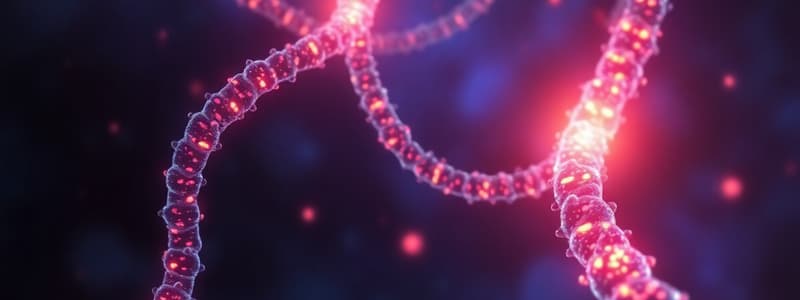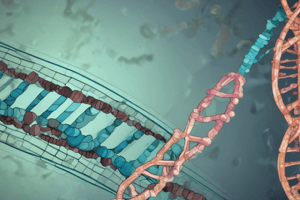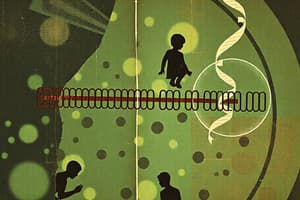Podcast
Questions and Answers
What is the primary role of Ang1 in relation to vascular integrity?
What is the primary role of Ang1 in relation to vascular integrity?
- Inhibiting TIE-2 phosphorylation
- Promoting endothelial cell migration
- Stabilizing vascular integrity (correct)
- Increasing angiogenic switch occurrence
Which of the following statements about Ang2 is accurate?
Which of the following statements about Ang2 is accurate?
- It primarily increases TIE-2 phosphorylation.
- It has no effect on vascular integrity.
- It is responsible for promoting endothelial cell migration. (correct)
- It enhances the stability of vascular structures.
What defines the angiogenic switch in tumor growth?
What defines the angiogenic switch in tumor growth?
- A balance favoring pro-angiogenic factors (correct)
- A state of increased anti-angiogenic factors
- A complete cessation of angiogenesis
- A decrease in existing blood vessel formation
Which of the following molecules is considered a pro-angiogenic factor?
Which of the following molecules is considered a pro-angiogenic factor?
In the context of cancer treatment, which of the following approaches has been proposed to manipulate tumor angiogenesis?
In the context of cancer treatment, which of the following approaches has been proposed to manipulate tumor angiogenesis?
What is one of the primary functions of telomeres in eukaryotic chromosomes?
What is one of the primary functions of telomeres in eukaryotic chromosomes?
In humans, what is the characteristic repeat sequence found in telomeres?
In humans, what is the characteristic repeat sequence found in telomeres?
What happens to telomeres in normal somatic cells as they age?
What happens to telomeres in normal somatic cells as they age?
What model describes the structure formed by G-rich telomeric sequences in solution?
What model describes the structure formed by G-rich telomeric sequences in solution?
What role does telomerase play in DNA replication?
What role does telomerase play in DNA replication?
What is the Hayflick limit related to in human cells?
What is the Hayflick limit related to in human cells?
What is a characteristic feature of senescent cells in culture?
What is a characteristic feature of senescent cells in culture?
What method is used to study the location and structure of telomeres?
What method is used to study the location and structure of telomeres?
What is the primary consequence of telomere dysfunction in cells during continuous divisions?
What is the primary consequence of telomere dysfunction in cells during continuous divisions?
Which mechanism primarily leads to the bypass of replicative senescence in murine cells?
Which mechanism primarily leads to the bypass of replicative senescence in murine cells?
What is the role of p19ARF in the cellular response to stress?
What is the role of p19ARF in the cellular response to stress?
Which of the following proteins is upregulated during human cell replicative senescence?
Which of the following proteins is upregulated during human cell replicative senescence?
How does the dysfunction of telomeres contribute to genomic instability in epithelial carcinogenesis?
How does the dysfunction of telomeres contribute to genomic instability in epithelial carcinogenesis?
What effect does the activation of telomerase have in carcinoma-in-situ stages?
What effect does the activation of telomerase have in carcinoma-in-situ stages?
What happens to cells experiencing prolonged culture that reach the Hayflick limit?
What happens to cells experiencing prolonged culture that reach the Hayflick limit?
In the context of cancer, what does the term 'angiogenesis' refer to?
In the context of cancer, what does the term 'angiogenesis' refer to?
What defines the role of the lymphatic system in relation to cancer?
What defines the role of the lymphatic system in relation to cancer?
What is the purpose of the breakage-fusion-bridge (BFB) cycle in cancer cells?
What is the purpose of the breakage-fusion-bridge (BFB) cycle in cancer cells?
What happens if p53 checkpoints are overcome or lost in cells?
What happens if p53 checkpoints are overcome or lost in cells?
Which cellular component is NOT primarily involved in the development of angiogenesis?
Which cellular component is NOT primarily involved in the development of angiogenesis?
What is indicated by high levels of genomic instability in mTERC, p53 double null mice?
What is indicated by high levels of genomic instability in mTERC, p53 double null mice?
Which signaling molecules are majorly involved during angiogenesis?
Which signaling molecules are majorly involved during angiogenesis?
Flashcards
Angiogenesis
Angiogenesis
Formation of new blood vessels.
VEGF
VEGF
Major signaling molecule that regulates angiogenesis.
Angiogenic switch
Angiogenic switch
Transition from no new blood vessel formation to active blood vessel formation.
Pro-angiogenic factors
Pro-angiogenic factors
Signup and view all the flashcards
Anti-angiogenic factors
Anti-angiogenic factors
Signup and view all the flashcards
Telomere Function
Telomere Function
Signup and view all the flashcards
Telomere Structure
Telomere Structure
Signup and view all the flashcards
Telomerase
Telomerase
Signup and view all the flashcards
Replicative Senescence
Replicative Senescence
Signup and view all the flashcards
Hayflick Limit
Hayflick Limit
Signup and view all the flashcards
Telomere Shortening
Telomere Shortening
Signup and view all the flashcards
Cancer Cell and Telomeres
Cancer Cell and Telomeres
Signup and view all the flashcards
FISH (Fluorescent in situ hybridization)
FISH (Fluorescent in situ hybridization)
Signup and view all the flashcards
Cellular Crisis
Cellular Crisis
Signup and view all the flashcards
Breakage-fusion-bridge (BFB) cycles
Breakage-fusion-bridge (BFB) cycles
Signup and view all the flashcards
p53
p53
Signup and view all the flashcards
Vascular Endothelial Cells (VEC)
Vascular Endothelial Cells (VEC)
Signup and view all the flashcards
Lymphatic System
Lymphatic System
Signup and view all the flashcards
Metastasis
Metastasis
Signup and view all the flashcards
p16Ink4A
p16Ink4A
Signup and view all the flashcards
Rb
Rb
Signup and view all the flashcards
Immortalization
Immortalization
Signup and view all the flashcards
Study Notes
Telomeres
- Telomeres are the ends of chromosomes in eukaryotic cells.
- They have three primary functions:
- Prevent chromosomal degradation.
- Prevent fusion of chromosome ends.
- Facilitate faithful replication of linear DNA ends.
- Telomeres have a unique, short repetitive sequence.
- Human telomeres contain the repeat sequence TTAGGG, highly conserved in vertebrates.
- This repeat sequence is repeated hundreds to thousands of times.
- Telomere length shortens with age in normal somatic cells.
- Cancerous and germ cells maintain telomere length.
- The 3' end of a telomere is a single-stranded overhang.
- Overhang length varies between organisms.
- Human overhangs are typically 125-275 bases.
- It is G-rich, allowing for non-Watson-Crick base-pairing. G-quartet formation and T-loop formation stabilize the telomere.
- Telomerase is essential for telomere replication.
- It's composed of an RNA template (TERC) and a reverse transcriptase catalytic subunit (TERT).
- Telomerase uses the G-rich strand as a template to synthesize new DNA at the 3' end.
- DNA polymerase fills the lagging strand. Repeating these processes lengthens telomeres.
- Telomerase activity is often elevated in cancer cells.
Replicative Senescence
- In dividing human cells, telomeres gradually shorten.
- This leads to cellular senescence, an irreversible loss of the ability to divide in culture.
- Senescent cells undergo morphological changes, express specific marker genes (like SA-β-galactosidase), and display altered behaviors (SASP).
- Shortened telomeres can activate cellular senescence despite growth factors and glucose being present.
- Signal from shortened telomeres activate Rb, p53, and p16Ink4A, inducing replicative senescence.
- Cancer cells can bypass senescence through the expression of the TERT subunit or through alternative mechanisms.
- In mouse cells, senescence bypass is linked to altered p16/p19 INK4A functioning indirectly through p19ARF stabilization of p53.
- Senescence can also be induced by cellular stress, activating p53 and Rb/p15 pathways, even independent of telomere erosion, by uncovering telomere ends alone.
Telomere Dysfunction and Cancer
- Prolonged culture of human cells leads to the Hayflick limit, activating checkpoints like Rb, p53, and p16InkA and triggering replicative senescence.
- Bypassing these checkpoints leads to crisis, with chromosomal instability due to breakage-fusion-bridge cycles. This creates amplified, deleted regions generating large amounts of damage and new mutations.
- Telomere dysfunction can activate apoptosis.
- If apoptosis is bypassed, cancer cells may reactivate telomerase (majority of cases) or use a mechanism called ALT to stabilize telomeres, which allows cells to grow.
- Ongoing epithelial turnover during aging, coupled with somatic mutations disabling oncogenic checkpoints, can lead to telomere shortening and genomic instability, contributing to carcinogenesis.
- This instability and mutations associated with telomere attrition can contribute to cancer progression.
- P53 mutation can attenuate growth arrest and apoptotic phenotypes, accelerating tumor development.
Angiogenesis
- Angiogenesis is the formation of new blood vessels from existing ones.
- Key cell types involved in angiogenesis are vascular endothelial cells, pericytes, and smooth muscle cells.
- Angiogenesis is crucial for tumor growth and delivery of anti-cancer therapeutics.
- Factors like VEGF, Ang1, Ang2, and PDGF influence these processes.
- VEGF is a major regulator of angiogenesis.
- Ang1 promotes vascular integrity by recruiting pericytes.
- Ang2 destabilizes the vascular structure.
- Pro-angiogenic factors (e.g., VEGF) and anti-angiogenic factors counteract each other. The balance between these factors determines the outcome.
- Statins and other molecules can inhibit angiogenesis.
Studying That Suits You
Use AI to generate personalized quizzes and flashcards to suit your learning preferences.




